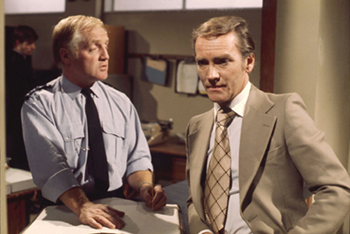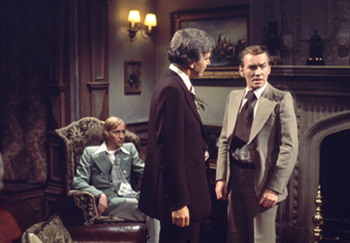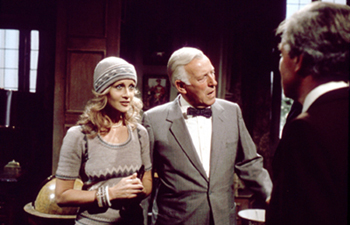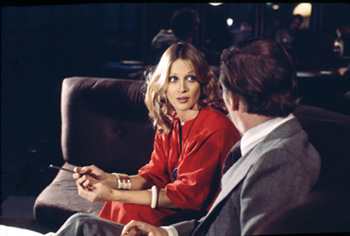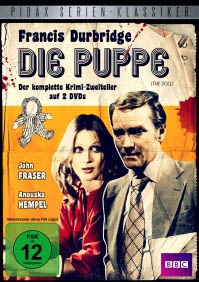FRANCIS DURBRIDGE PRESENTS: THE DOLL
Original tx 25.11.75 / 02.12.75 / 09.12.75
Cast: John Fraser (Peter Matty), Anouska Hempel (Phyllis Du Salle), Geoffrey Whitehead (Claude Matty), Cyril Luckham (Sir Arnold), Derek Fowlds (Max Lerner), William Russell (Julian Osborne), Sarah Brackett (Linda Braithwaite)
Director David Askey Writer Francis Durbridge Film Camera John Williams Film Editor M.A.C. Adams Film Sound Bill Chesneau Designer Michael Edwards Studio Lighting Bob Gell Studio Sound Alistair Askham Costume Designer Tudor George Make-up Gwen Arthy Vision Mixer Roger Sutton Producer Bill Sellars Production Assistant Peter Grimwade
German
John Fraser (R). (c) BBC / Pidax Film
A distracted Peter Matty almost becomes a victim of the London traffic, and his fellow people seem to confuse him considerably. Why is Peter in such a state? He sets off to explain it all to his brother Claude, in a flashback ...
I believe it would be inappropriate to disclose too much film content. After all there might be viewers around who have never seen this, or who have forgotten all about it and may wish to re-experience vintage Durbridge. Instead, I'll try to offer some background reflections and behind-the-scenes detail, of which, admittedly, relatively little is known at this point.
That statement is valid for director David Askey (The Gentle Touch, Tenko, The Dark Side of The Sun) as well. One thing is certain though, his choice of casting for The Doll was inspired. The leads - both immigrants, as it were - picked by him were by no means known as reliable TV stalwarts who get the job done. Rather, they came to be known as two larger-than-life individuals, and quite possibly that common ground triggered the special on-screen chemistry between them which is evident throughout the serial: their interplay and rapport is perfectly natural, as opposed to "acted". (Yes, I know - there is always a degree of subjectivity in that kind of observation.)
The elusive Mr. Askey has a reputation of being an "actors' man", taking their concerns very seriously. This is not the usual and logical state of affairs on any TV film set when we bear in mind that the TV director usually has to combat the clock and the budget, with the production company pleading poverty ... Trevor Baxter, a character actor playing alongside Emily Richard, Peter Egan and Patrick Mower in The Dark Side of the Sun (1983), described his working relationship with the director thus:
"(David Askey) was very skilled in drawing from the actor the core of his performance, by giving him confidence, and then profiling it by encouraging the interpretation to go in whatever direction he thought best. I always found him kind and courteous, understanding of an actor's sensibilities and refreshingly free from playing the sort of power games in which some directors seem to find their raison d'etre."
(David Rice, "Michael J. Bird: The Life and Work of the Man Who Created The Lotus Eaters", Krasakis Press, 2006, p.143)
Geoffrey Whitehead, William Russell, John Fraser. (c) BBC / Pidax Film
John Fraser, and I say this with some degree of disappointment, did not mention participating in any TV production, let alone The Doll, in his autobiography. No, a self-respecting actor only has two areas of work they can be proud of: film and the Theater. The latter is good for prestige, TV only pays your bills, is a common stance. One is a Shakespearean actor ... "Von Kopf bis Fuss", as he would put it.
In 1975, Fraser was no longer a juvenile lead but an - admittedly good-looking - man in his mid-40s. In contrast to his predecessors (Gerald Harper in A Game of Murder, Francis Matthews in Paul Temple), he sports a certain boyish aura which helps to make the initial plot development - i.e. the protagonist falling in love, head over heels, with a passing stranger - credible. Having said that, similar to Harper or Jack Hedley (in The World of Tim Frazer), he is not a man of superpowers and not even someone who might be able to "look after himself" when danger lurks around the corner. Hence, not only do these average person qualities invite viewer indentification, they make the Durbridgian web of intrigue and murder look even more threatening.
Once again, I have no wish to give away too much ... but if you want to know which subject matters - as opposed to television work - are dear to the actor's heart, please consult pp. 34-5 of "Close-up: An Actor Telling Tales".
Anouska Hempel, Cyril Luckham, William Russell. (c) BBC / Pidax Film
Anouska Hempel, for one, is representative of a new kind of Durbridge casting. Up to 1969, the Durbridge heroine was the nice next-door girl, June Barry in A Game of Murder being a prime example. In 1975, acting abilities are still important sure enough, but so are glamourous looks, enhanced by costume and make-up department. This approach had been tested with Ros Drinkwater on Paul Temple. Ros did not always like the way the writers and producers saw her role, but there were consistently interesting results, as episodes like Games People Play prove. Those results did not just come about because Temple was filmed in colour. Directors, notably Philip Dudley and Michael Ferguson, regularly found a clever way of integrating "style" into the story.
Mrs. Hempel came equipped with experience: she had played the scantily-clad astrologer Esther Jones in Zodiac, an all-too-brief series written by Roger Marshall in which she had starred alongside Anton Rodgers. Some sources insist that series was popular in the early 1970s due to a widespread rising interest in supernatural phenomena, but I'd like to suggest that casting was a key factor, too. Forget the crystal ball, watch Anouska as she walks around in something which seems perfect for a really hot summer day ... (This was taken up for Doctor Who later, when Louise Jameson wore a tight, revealing outfit to attract the Dads of the target audience as well.)
Anouska Hempel, John Fraser. (c) BBC / Pidax Film
Mrs. Hempel is in charge of a design agency these days, rendering services for - to put it very bluntly - an exceptionally wealthy clientèle. What's more, she does not like to discuss her acting career, less so because of Zodiac and The Doll but due to other roles which we won't mention here, because we want to show respect. When Tim Greaves set out to compile a richly illustrated account of that career a number of years back, he was facing strong opposition, and the project ultimately fell through.
You can try to exterminate the past, but there are some who won't play ball and join the resistance movement ... As for this reviewer, I'm following in Peter Matty's footsteps. Offer me a 1970s photo of Mrs. H. (that usually happens on Ebay these days), and I'll go chasing after it. Thankfully the price, although normally fairly high, is nothing compared to that of anything offered by Hempel Design.
The German company Pidax Film have joined the aforementioned movement as well: by releasing The Doll on DVD in 2013. Instead of the original three parts, they have re-edited the material to two (of c.60/c.90 minutes respectively), which corresponds to the original German version broadcast on two consecutive nights in 1982. An English soundtrack is available (no subtitles). You can order directly from Pidax (www.pidax-film.de, note that foreign posting is without extra charge) or go to www.amazon.de.
This is an unofficial and non-commercial website. The rights to The Doll are held by the BBC. The sole purpose of this page is to promote the abovementioned series - no copyright infringement is intended. However, should the copyright holders be unhappy with my use of still photographs the material in question will be removed immediately.
<BR>
<DIV>
<H5><A HREF="../index.html">Main</A></H5>
<H5><A HREF="../film-main.html">Film & TV</A></H5>
<H5><A HREF="../contact.html">Contact</A></H5>
<H5><A HREF="../introtext.html">Introduction</A></H5>
</DIV>


